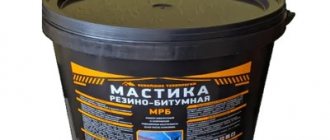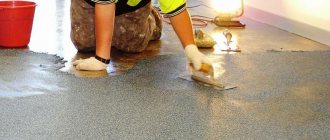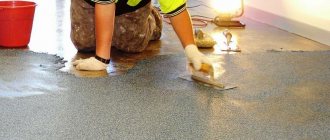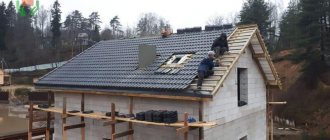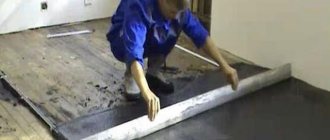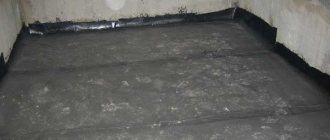Every second a private house resists the action of external factors, the most destructive of which is dampness. Groundwater, seeping inside, can change the indoor microclimate; salts dissolved in water change the structure of concrete and wood. The entire structure, including floors, must be protected from high humidity. Reliable waterproofing for the floor will allow you to avoid many troubles, among which a damaged carpet will be the most minor problem.
A more serious symptom may be the appearance of an unpleasant odor, indicating the development of fungus and the onset of rotting. A frivolous attitude will lead to the need to replace floors. Concrete floors can also be subject to corrosion.
Waterproofing the floor is essential in wet areas Source pinterest.com
Requirements for floor waterproofing
The waterproofing strategy is regulated by many regulatory documents. During work, it is necessary to be guided by the requirements of SNiP 3.04.01-87 (section 4, which talks about the construction of floors) and SNiP 2.03.13-88 (about floors). In accordance with these documents, waterproofing must be installed in the floor structure of wet rooms (bathrooms, toilets, saunas).
It would also be useful to become familiar with Instruction VSN-9-94 DS (installation of floors in residential and public buildings) and the specifications for the materials used. According to building standards, floors in wet rooms are installed a few centimeters below the main level of other rooms. This technique allows you to retain water in a limited space and quickly eliminate the consequences. A step or border is placed at the entrance.
Properly organized threshold to the bathroom Source prihozhaya.guru
Types of insulating materials
All types of waterproofing materials can be divided according to the place of application - for external or internal. Division by composition is also valid. Then they are called bitumen, polymer, mixed (bitumen-polymer) and including mineral components.
In most cases, it is convenient to distinguish materials for waterproofing by the method of application. The most effective and therefore popular are:
- Roll, film (membrane, lining) materials ; including painting, coating, plastering compounds and mastics. These options are optimal for those who want to carry out the work themselves. Difficulties may arise with high-quality installation and connection of parts of the roll covering.
Roll materials are a reliable way to protect the floor Source myprofnastil.ru
- Penetrating waterproofing . Its use is accompanied by a number of conditions, and when applying it is important to strictly follow the instructions.
- Bulk waterproofing . A labor-intensive option used under screed. Upon contact with water, the granules form a gel (paste), stopping its further spread.
- Self-leveling polymer floors (3D floors) . A capricious and unpredictable material for floor waterproofing if there is no practical experience and equipment.
- Sprayed polymer coatings (polyurea) . For high-quality application, experience, special clothing and appropriate equipment are required.
See also: Catalog of companies that specialize in house design
Roll insulators
The most durable and hard materials with a low degree of moisture absorption are usually sold in roll form. The basis of such material is: bitumen, glass fiber or fabric, polyethylene. Modern manufacturers replace bitumen with synthetic materials to eliminate the unpleasant odor of the coating.
The installation method determined the formation of the following types of rolled waterproofing materials:
- Self-adhesive. They are pre-equipped with an adhesive layer, so they are simply laid on a prepared rough base.
- Requiring warming up. Heating such a material makes it more plastic and increases its adhesion to the base, i.e. it can be glued without the use of auxiliary means.
- Used in combination with an adhesive mixture.
Nuances of choosing insulating material and technology
Waterproofing the floor in an apartment or private house is responsible not only for sealing, but also partially for ventilation of the room. Attention to the selection of materials (as with any work) will help to further increase the energy efficiency of a private home with corresponding savings in money.
Different methods of applying coating waterproofing Source ar.decorexpro.com
When choosing various options, future consumption (based on the area and nature of the premises) and the final cost are assessed. The opinion of a specialist with experience in arranging various types of insulation will be extremely useful.
Different rooms may require individual installation technology. To choose the optimal method, take into account the characteristics of the surface and the time frame within which the work must be completed.
Features of popular waterproofing methods
Protecting floors from moisture can be done in different ways. After arranging the waterproofing, in most cases the floor is screeded, after which tiles, laminate or other covering are laid. There are several ways to carry out protective work:
Waterproofing of a bathroom using the adhesive method Source tirez.ru
Pasting method of waterproofing
The material (roofing felt, glass roofing felt, roofing felt, polyethylene, polypropylene, PVC film) is cut to the size of the room. Then the prepared parts are glued to the primed plane, overlapping or end-to-end; in the latter case, the seams must be welded or glued. Polymer multilayer membranes, which also have thermal insulation properties, are used. Which waterproofing is best for the floor is decided in each case individually.
Coating (painting) waterproofing
Coating waterproofing of a wooden floor in a private house is the most affordable and therefore widespread method. Bitumen, plaster mixtures, mastics (bitumen-polymer and bitumen-rubber), sealants and polymer varnishes are used as waterproofing. The base, cleared of debris and contaminants, is moistened and then treated with a primer to ensure better adhesion. Following the manufacturer's instructions, the mixture is prepared.
Floor waterproofing material is applied with a brush, roller or spatula; after 4-6 hours, lay the second layer; the final thickness does not exceed 2-20 mm. After finishing the work, the seams are sealed (places where the floor meets other surfaces and where pipes enter); Screeding and laying tiles can begin within a day.
Completed painted bathroom insulation Source bestnovosel.ru
Coating waterproofing is applied to any surface; it is easy to treat hard-to-reach places. It is considered a quick method; but over time, cracks may appear on the surface of the bitumen or polymer coating.
Backfill waterproofing
This method is suitable for protecting the floor of wet rooms. Formwork is mounted on the base. Bulk materials are added (concrete, hydrophobic powders, perlite sand or ash, asphalt insulation).
Under the influence of water, the granular mixture is evenly distributed and acquires the consistency of a gel, becoming a barrier to further spread of moisture. The thickness of such waterproofing can reach up to 50 cm.
Plaster waterproofing
Plaster materials for floor waterproofing have an important advantage - at 0⁰C they do not lose their properties and do not form cracks (like bitumen, for example). Plaster waterproofing is easy to use and environmentally friendly. The mixtures contain cement, gypsum, mineral and polymer additives, which make the elastic layer resistant to strong temperature fluctuations (from -20 ° C to +50 ° C).
Preparing the floor for waterproofing Source renovationjunkies.com.au
Waterproofing tape: can it be replaced?
The tape significantly increases the cost of waterproofing in the bathroom, but attempts to save on it inevitably lead to a decrease in the reliability of the waterproofing layer. This statement is repeatedly supported by the negative experiences of FORUMHOUSE participants. Many of them believe that doing GI without tapes is completely pointless, it is better not to do it at all - then they will save money on the next repair.
However, the experience of others is not meaningful to everyone, and questions about the need for waterproofing tape remain.
Ution785
Why do you need waterproofing tape? Can't you live without it? What happens if you don't put it in?
You can't do it without waterproofing tape. The rupture of the waterproofing membrane in an individual house can occur due to any movement of the house, and if so, then it occurs precisely in the corners.
The tape ensures that the waterproofing will not break.
But, of course, no one can forbid the homeowner to believe that all these developments can occur in any house except the one that belongs to him.
Our users also categorically do not recommend replacing specialized tapes with something else, for example, a rubber bandage. A rubber bandage will not retain elasticity for a long time and will not provide reliable adhesion of the waterproofing to the base.
Video description
An unusual protection option is a 3D self-leveling floor in the video:
The material is distributed over a primed concrete base in two ways - hot or cold, in several stages. Then the surface is dried with hot air (gas burner, IR radiation). For additional reliability, the layer is reinforced with fiberglass or metal mesh. The thickness of the finished film is from 5 to 15 cm.
Impregnating (penetrating) waterproofing
For protection, solutions of concrete, concrete-polymer or cement composition with chemically active additives (polymers, salts of alkali and alkaline earth metals) are used. This composition is able to penetrate deep into the concrete surface (some 50-60 cm), making it waterproof. You can immediately lay ceramic tiles on top of the waterproofing.
Waterproofing of a wooden floor, logs (beams for flooring) Source bg.decoratex.biz
Insulating fills
These compositions not only have good moisture-proofing characteristics, but also make it possible to level out residual unevenness in the base. In their production, bits and asphalt concrete are used.
Filling is performed as follows:
- First, the subfloor is cleaned.
- Any small cracks, chips and other defects are repaired with putty.
- Then the surface is treated with several layers of soil mixture.
- The filling composition itself is also applied in 2-3 layers. The order should be maintained, i.e. After the first application, you must wait until the layer dries and then apply the next one.
- It is necessary to distribute the mixture evenly over the floor using a roller with needles.
- The total thickness of the poured layer should be about 2.5 centimeters.
Such waterproofing can only be carried out over floors with concrete screed. Floating cannot be done on “floating” floors, since the poured layer will crack when the surface vibrates. As a result, the surface coating is also deformed, which will look terrible in the photo and during visual inspection. The floors will have to be restored immediately, since they will no longer be usable.
Features of waterproofing a wooden floor
Wood is a naturally porous material that easily absorbs moisture. Because of this feature, an unprotected wooden surface inevitably begins to deform, crack and rot.
To protect the wooden floor from harmful influences, a subfloor waterproofing technology has been developed. Ventilation must be installed between the rough and finished floors. This design will ensure natural air circulation, maintaining a comfortable microclimate in the house.
Waterproofing the subfloor in a wooden house is a mandatory element. For concrete slabs, moisture-impermeable materials (roofing felt, polyethylene film) are used. For wooden subfloors, treatment with building compounds (varnishes with polymers or bitumen-based) is chosen. Sometimes, due to the characteristics of the house, the coating is installed on joists.
Technology for making gravel-sand cushion
- Preparation of the base consists of leveling the soil under the future floor and removing from it the fertile layer containing organic impurities. This is usually done at the stage of site preparation for construction.
- Crushed stone with a fraction size of no more than 50 mm is poured onto the prepared soil. Backfilling is carried out over the entire floor area. The gravel is compacted and leveled to eliminate large differences in height. The thickness of the layer is at least 0.2 m, and in areas with close groundwater - at least 0.5 m.
Gravel compaction process - Backfill with coarse sand in a layer of 0.1-0.4 m. The sand is spilled with water and thoroughly compacted with a hand roller.
- Cover the gravel-sand cushion with a layer of geotextile. Geotextile strips are glued using a construction hair dryer. Geotextiles play the role of a shock absorber and protect the insulation and waterproofing from damage.
- Foam insulation, for example, polystyrene or penoplex, is placed end-to-end on top of the geotextile. Polystyrene foam is not recommended due to its low mechanical strength.
- After completing these operations, you can waterproof the prepared base with rolled materials or immediately begin screeding the floor.
What to pay attention to when performing work
New buildings are characterized by high humidity. Such a microclimate in the house can not only ruin repairs, but also damage the load-bearing parts of the structure. Waterproofing a house is carried out in the following order: foundation, basement (if any), floors. This way you can protect wooden structures from rotting, and metal ones from corrosion.
One of the types of decorative self-leveling floors with protective properties Source zen.yandex.ru
Due to poor-quality waterproofing of the floor of the first floor of a house, doors often suffer. Moisture rises up the wall and saturates the unprotected parts of the wooden frame. The structure loses strength, becomes deformed, becomes loose and begins to rot.
Oil paint or varnish is not waterproofing. Their service life is limited to 4-5 years, after which they begin to crack and crumble. Also, floor tiles cannot be used as a waterproofing material - this is a finishing material.
Liquid membranes
The popularity of liquid membranes for waterproofing screeds, floors, walls and other internal structures in houses and apartments is increasing every year. The basis of the composition is bitumen, as well as its plastic additives, which provide the necessary parameters of viscosity and elasticity during use and after hardening. It is supplied in liquid form. Before use, simply stir the liquid well. The advantages of membrane coatings include the following:
- tensile strength;
- elasticity;
- resistance to external factors;
- optimal barrier properties;
- good adhesion;
- creating a seamless coating;
- minimum thickness when applied. The thickness when applied in 2 layers is 0.5–0.8 mm.
The use of liquid compositions for membrane protection is most important in rooms with constantly high air humidity and the possibility of leaks. Therefore, they are used for finishing floors before installing screeds in the bathroom, toilet or kitchen. Sealing cracks during application is the best guarantee that the base of the floors will not be damaged even if the building is flooded.


